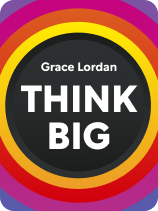

This article is an excerpt from the Shortform book guide to "Think Big" by Grace Lordan. Shortform has the world's best summaries and analyses of books you should be reading.
Like this article? Sign up for a free trial here.
Do you like to imagine yourself as different in some way? What if you could create and travel a path toward your ideal self?
In Think Big, behavioral science expert Grace Lordan argues that most of us fail to transform our lives because we try to change too much too quickly. Instead, we must set a big goal, acknowledge that achieving it will take a few years, and then take the regular, small steps necessary to achieve it.
Continue reading to learn how to become the person you want to be.
Become the Person You Want to Be
Whether your goals are personal or professional in nature, you can use Lordan’s advice for how to become the person you want to be. Here are the four steps she recommends.
Step #1: Know Who You Want to Be
The first step to changing your life, Lordan argues, is to identify your ideal future self—which Lordan calls your “ME+” and which we’ll call your ideal self. Imagine a typical workday in the life of your ideal self—anywhere between two and 10 years from now. What is their job title and the field in which they work? What kinds of tasks fill up their day? If you’re uncertain about the former, focus on the latter, imagining what work tasks you’d love to do all day. Ideally, these tasks will feel significant—both in your own life and with regard to the impact you have on others—as we tend to try harder to achieve goals that we deem significant.
Make sure that the future self you envision reflects your true desires. Lordan cautions against falling victim to the cognitive bias called the ambiguity effect: a tendency to choose the option (goal) where you know the probability of a favorable outcome—even if you’re not as excited about that goal. Additionally, avoid the bandwagon effect—the tendency to do whatever the people around you are doing—and reactance bias—the rebellious instinct to stick with something specifically because others don’t like it.
Once you’ve identified your ideal self, Lordan contends that you must figure out what skills your ideal self has that you need to develop. Ask yourself: Why am I not currently able to be this ideal self? If you’re unsure, find some people whose jobs are similar to those of your ideal self, and determine what skills they use regularly that you lack. Pick three to five skills that you can reasonably develop: You should be able to develop them by working on them a little bit every week, and developing them shouldn’t cost prohibitive amounts of money.
Step #2: Practice New Skills
Lordan explains that once you know what skills you need to develop to become your ideal self, you need to regularly practice them. This is because becoming your ideal self requires that you master the skills you identified—and to master them, you must practice them until they become so ingrained that they’re habitual. Start by writing the skills down somewhere you’ll regularly encounter them: Our saliency bias dictates that we pay more attention to information that’s conspicuous.
Then, Lordan recommends that you plan how you’ll regularly practice these skills. To do so, first look at your current job: How could you adjust your responsibilities so that you spend more time developing the skills you desire? Second, decide how you’ll improve upon these skills in your personal time; for example, you might commit to watching YouTube videos that teach you a particular skill.
| Other Ways to Practice New Skills In Ultralearning, Young provides an alternate method for practicing the skills you need. To start, figure out exactly what you need to learn by breaking down each skill or topic into three categories. Facts are things you need to commit to memory, concepts are ideas that require flexible understanding, and procedures constitute anything that requires practice. Although Young doesn’t recommend writing down the skills themselves so that you’ll regularly see your list, he does suggest highlighting the skills you expect the most difficulty from so that you can prepare for potential challenges in advance. Then, Young suggests that you plan how you’ll learn the skills you need. But he doesn’t suggest dividing up the plan by whether you’ll learn on the job or in your personal time. Instead, Young recommends that you first research how others have learned what you want to learn so that you can identify what everybody has in common. Then, take those commonalities and re-prioritize them so that your learning strategies help you learn what’s most important at any given time. For example, if you want to learn to speak Spanish for an upcoming trip to Spain, you might prioritize learning pronunciation and delay the study of spelling. |
Step #3: Build Relationships
Lordan asserts that you must also plan how you’ll develop the relationships that will help you become your ideal self. Start with the people you already know: Every month, ask someone you know for help on your journey to becoming your ideal self. Lordan recommends starting with people you know at work, as they’ll likely have the relevant expertise.
Additionally, every month, reach out to people you don’t know who could help you—like a leader in an industry you want to break into—and ask them to meet. Maximize the chances they’ll say yes by explicitly stating how your request can add to their lives; this takes advantage of the framing effect, which dictates that how you communicate information influences how someone interprets it.
When deciding who you’ll reach out to, Lordan recommends actively seeking out diverse perspectives. Thanks to your similarity bias—your preference for people who are like you—you may try to speak with people who are all like you (and therefore like each other). You may also have a stereotype bias—an assumption about all the individuals in a group—that affects your list. Both tendencies are counterproductive. In reality, diverse perspectives are more likely to help you on your journey, as the more diverse the people you speak with, the wider the range of experiences you’ll encounter—and the more varied the advice they’ll give.
Step #4: Make a Plan
Finally, Lordan recommends that you plan out when you’ll do the activities that help you become your ideal self. At the very least, devote 90 minutes in your weekly schedule to these activities—whether that’s developing skills or developing relationships. This is enough time to ensure progress but not so much that it overwhelms you.
Lordan adds that you should devote one hour weekly to reviewing your progress and planning next week’s tasks. Specifically, review how these activities relate to your ultimate goal; the more clear you are on why you’re doing them, the more likely you are to stick with them. Additionally, reflect on how much you enjoyed each activity; this will help you realize if you’re spending time doing something you think you like and not something you actually like.
(Shortform note: In Indistractable, Nir Eyal proposes an alternate method for scheduling your time so that you’re working toward becoming your best self. First, identify what you value in the three main areas of your life: you, your relationships, and your work. For example, you may value mindfulness, time with your kids, and the work activities that help you become your ideal self. Second, timebox: Devote every block of time in your schedule to a specific activity, prioritizing what you value most. Third, each time you get distracted from this schedule, note down how and why. Fourth, spend 20 minutes every week reflecting on what distracted you and how you can alter your schedule to reduce future distractions.)

———End of Preview———
Like what you just read? Read the rest of the world's best book summary and analysis of Grace Lordan's "Think Big" at Shortform.
Here's what you'll find in our full Think Big summary:
- Why most of our attempts to transform our lives fail
- How to overcome the cognitive biases that hold us back from our goals
- How to take the necessary small steps to change your life long term






